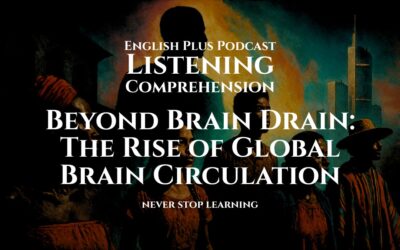Listening for Instructions and Advice
This listening exercise features a librarian giving advice. This is a common format in exams where you need to understand instructions or steps. To succeed, try these strategies:
- Identify the Structure: The librarian will likely list their tips. Listen for number words (“First,” “Second,” “Tip number three…”) or transition phrases (“Another great tip is,” “Next, you should,” “Finally”). This helps you organize the information in your head.
- Focus on Action Verbs: Each piece of advice will have a key action. What is the listener supposed to do? Listen for the main verb in each tip (e.g., “Start,” “Find,” “Create,” “Quit”).
- Note the ‘Why’: Good advice always comes with a reason. The librarian won’t just say, “Read every day.” They will explain why it’s a good idea. Listening for this justification will deepen your comprehension.
Let’s head to the library.
Anticipating the Topic: A Librarian’s Guide
You’re about to hear a librarian give a short, encouraging talk on how to build a lasting reading habit. The goal is to provide simple, actionable steps. Expect to hear practical advice that goes beyond just “read more.” Think about the common problems people face when trying to read more, and see if the librarian addresses them.
Key Vocabulary and Phrases
Understanding these words will help you follow the librarian’s practical advice.
Cultivate: To try to acquire or develop a quality or skill.
How we used it: “Hello everyone, and welcome. Today, I want to talk about how to cultivate what is, for me, one of life’s greatest pleasures: a reading habit.”
Daunting: Seeming difficult to deal with; intimidating.
How we used it: “…the idea of finishing a 500-page novel can feel daunting.”
Incremental: Increasing or adding on, especially in a series of small steps.
How we used it: “The goal here is incremental progress, not immediate perfection.”
Momentum: The force that keeps an object moving or keeps an event developing after it has started.
How we used it: “Once you build a little bit of momentum, it becomes much easier to continue.”
Curate: To select, organize, and look after the items in a collection or exhibition. Here, it means to carefully choose.
How we used it: “My advice is to curate your own personal reading list based on what genuinely excites you.”
Palatable: Pleasant or acceptable.
How we used it: “Make reading more palatable by connecting it to your existing passions.”
Designated: Officially assigned to a particular status or purpose.
How we used it: “My third tip is to create a designated reading space.”
Accessible: Able to be reached or entered. Easy to get.
How we used it: “Keep your current book somewhere visible and accessible.”
Piggyback: To use something that someone else has made or done in order to get an advantage. Here, it means linking a new habit to an old one.
How we used it: “The idea is to piggyback the new habit you want to form onto an existing, automatic habit.”
Abandon: To cease to support or look after; to desert. To give up on something.
How we used it: “Tip number five, and this might be the most important: learn to abandon a book without guilt.”
Accountability: The fact or condition of being responsible for something.
How we used it: “This adds a gentle layer of social accountability, which can be a powerful motivator.”
Incorporate: To take in or contain something as part of a whole; to include.
How we used it: “Think about the small, empty pockets of time in your day and how you can incorporate reading into them.”
Listening Audio
Listening Transcript: Please do not read the transcript before you listen and answer the questions.
Hello everyone, and welcome. Today, I want to talk about how to cultivate what is, for me, one of life’s greatest pleasures: a reading habit. So many people I meet here in the library tell me the same thing: “I wish I read more, but I just can’t find the time,” or “I can’t seem to focus like I used to.” If that sounds like you, please know that you are not alone. In our busy, distraction-filled world, building a consistent reading habit can be a real challenge. But it is absolutely achievable. The key is to stop thinking of it as a matter of willpower and start thinking of it as a matter of strategy. So today, I’m going to share five simple, practical tips to help you get started.
My first tip is: start ridiculously small. I cannot stress this enough. When you haven’t been reading regularly, the idea of finishing a 500-page novel can feel daunting. That feeling can stop you from even starting. So, forget the big goals for now. Instead, commit to something incredibly easy. For example, commit to reading just one page a day. Or for just five minutes a day. It sounds too simple to work, but it’s powerful for two reasons. First, it’s almost impossible to fail. You can always find five minutes. Second, it gets you past the hardest part: starting. Once you build a little bit of momentum, it becomes much easier to continue. Often, you’ll read for five minutes and find you want to keep going. The goal here is incremental progress, not immediate perfection.
Tip number two: find your ‘what’ and your ‘why’. A lot of people feel like they should be reading certain books—the classics, the prize-winners, the non-fiction books everyone is talking about. This pressure can kill the joy of reading. My advice is to curate your own personal reading list based on what genuinely excites you. If you love fantasy movies, read a fantasy novel. If you’re passionate about cooking, read a chef’s memoir. If you just want a fast-paced, entertaining story, pick up a thriller. Make reading more palatable by connecting it to your existing passions. And your ‘why’ is just as important. Why do you want to read more? Is it to relax? To learn something new? To escape? When your motivation is clear, you’re more likely to stick with it.
My third tip is to create a designated reading space. Our brains are wired to associate certain places with certain activities. If you always try to read in bed right before sleep, your brain might associate reading with sleepiness. If you try to read on the sofa with the TV on, your brain will be pulled towards the distraction. Find a comfortable chair, maybe in a quiet corner of your home. Put a lamp there, a small table for a cup of tea. Make it your official reading spot. When you sit there, you’re signaling to your brain that it’s time to focus and read. And on a related note, make your book visible. Don’t hide it in a drawer. Keep your current book somewhere visible and accessible, like on your coffee table or your nightstand. Seeing it serves as a constant, gentle reminder of your goal.
Okay, tip number four is to use a technique called “habit stacking” or “piggybacking.” This is one of my favorites. The idea is to piggyback the new habit you want to form onto an existing, automatic habit. For example, do you have a cup of coffee every single morning without fail? That’s an existing habit. Stack your reading habit on top of it: “After I pour my morning coffee, I will read for ten minutes.” The coffee becomes the trigger for reading. Or maybe you take the bus to work every day. That’s your trigger. “When I sit down on the bus, I will pull out my book.” Think about the small, empty pockets of time in your day and how you can incorporate reading into them. Waiting for an appointment, during your lunch break, while water is boiling for pasta. These small moments add up.
Finally, tip number five, and this might be the most important: learn to abandon a book without guilt. Life is too short to read books you are not enjoying. It’s not a failure to stop reading a book. Reading is supposed to be a pleasure, not a chore. If you are 50 or 100 pages into a book and you feel like you have to force yourself to pick it up, just stop. Put it down and pick up something else. Forcing yourself through a book you dislike is the fastest way to kill your reading momentum and make you associate reading with boredom. Giving yourself permission to quit books is incredibly liberating. There are millions of books out there. Your only job is to find the ones that speak to you. You can even join a book club or tell a friend what you’re reading. This adds a gentle layer of social accountability, which can be a powerful motivator.
So, to recap: start small, find your ‘what’ and ‘why’, create a reading space, use habit stacking, and quit books without guilt. Reading isn’t an all-or-nothing game. It’s a personal journey. Be patient with yourself, celebrate the small wins, and welcome to the wonderful world of books.










0 Comments